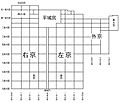Tenpyō facts for kids
The Tenpyō (also called Tempyō) was a special time period in Japanese history. It was like a way of counting years, called a nengō. This era came after the Jinki period and before the Tenpyō-kanpō period.
The Tenpyō era lasted from August 729 to April 749. During this time, the ruler of Japan was Emperor Shōmu.
Contents
Key Events of the Tenpyō Era
Changes in Japan's Capital City
During the Tenpyō era, Japan's capital city moved several times.
- 740: The capital was set up in Kuni-kyō.
- 744: The capital moved again to Naniwa-kyō.
- 745: The capital returned to Heijō-kyō. This city is now known as Nara.
Important Events and People
- 740: The army of Fujiwara no Hirotsugu was defeated in Hizen Province, which is on the island of Kyushu.
- 741: Emperor Shōmu ordered the building of Buddhist temples in different parts of Japan. Monasteries, which are places where monks live and worship, were also built in the provinces.
- 743: The Emperor gave an order to create a very large statue of the Buddha, known as a daibutsu. This huge statue would become part of the Tōdai-ji temple in Nara.
- 749: Former-Empress Genshō passed away.
- 749: After ruling for 25 years, Emperor Shōmu decided to step down. He became a Buddhist priest. His daughter then took over as the new ruler. She was confirmed as Empress Kōken.
Images for kids
-
A plan showing the layout of Heijō-kyō
Related Pages
- National Diet Library, "The Japanese Calendar" -- historical overview plus illustrative images from library's collection
See also
 In Spanish: Tenpyō para niños
In Spanish: Tenpyō para niños

All content from Kiddle encyclopedia articles (including the article images and facts) can be freely used under Attribution-ShareAlike license, unless stated otherwise. Cite this article:
Tenpyō Facts for Kids. Kiddle Encyclopedia.

